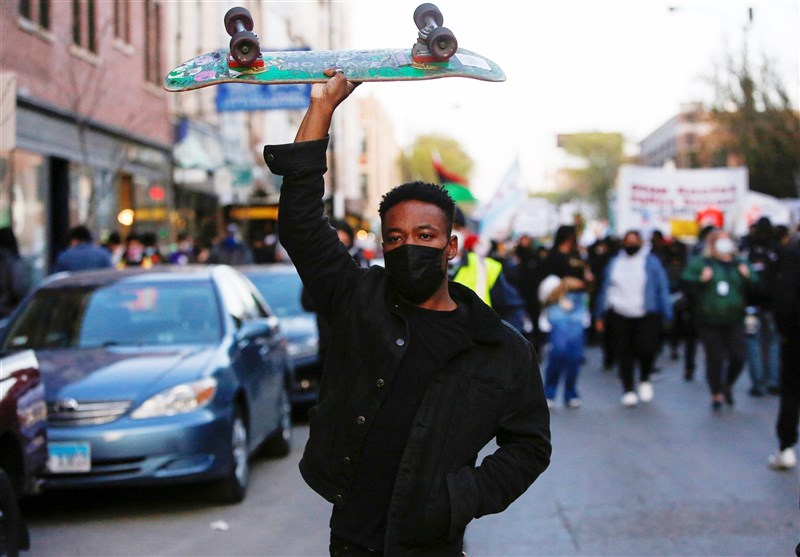Advocates Demand Use-of-Force Laws amid US Police Violence against Children
TEHRAN (Tasnim) – The recent deaths of two black teenagers by police — Adam Toledo, 13, in Chicago, and Ma'Khia Bryant, 16, in Columbus, Ohio — highlight a major flaw in policing practices and oversight which led to advocates suggesting child-specific training for US police.
Policies meant to stop police killings and the use of excessive force against civilians say little about interactions with children. The lack of oversight applies in schools across the country, where more officers have been called upon to patrol the halls, as well as on the streets. No sweeping federal laws regulate the police use of force against those 17 and under, and most law enforcement agencies don't have clear protocols, NBCNews reported.
"Policies seem to apply to both adults and juveniles equally — looking at factors like the threat posed by the subject, the physical size of the subject, how they're reacting to the police officer," said Jessica Huff, a research associate at the University of Cincinnati's Center for Police Research and Policy. "And a lot of those things aren't necessarily age-specific."
Organizers, academics and advocates have several suggestions about what should be done: Some say police need child-specific training, while others, including those who want to abolish the police, say that, short of full abolition, there should be fewer police encounters with minors and stricter legislation to oversee it. In most jurisdictions, police officers are directed to use their own discretion, said Christina Quaranta, executive director of the Connecticut Justice Alliance, an advocacy group.
"At worst," she said, "it leaves the door open for the police officer to become violent with a young person and know there's not a certain piece of legislation or a law that's been passed that could push back on what they did."
Before Adam's and Ma'Khia's deaths, video of officers pepper-spraying a 9-year-old girl in Rochester, New York, choking a 13-year-old boy in Baton Rouge, Louisiana, and wrestling an 11-year-old to the ground in Farmington, New Mexico, had thrust the issue of police encounters with children and teenagers into the spotlight.
Lisa Thurau, founder of Strategies for Youth, which trains police officers to interact with children and tracks use-of-force lawsuits, said organizations like the Commission on Accreditation for Law Enforcement Agencies, or CALEA, develop standards for law enforcement agencies — including releasing minors to their families instead of arresting them and referring them to counseling agencies instead of sending them to court. But the lack of federal oversight means ensuring that those standards are followed are an "aspirational goal" at best, she said.
"Even the legislative approach cannot always provide the level of protection you might need," Thurau said. "Most of the interactions between law enforcement and kids" aren't with federal agents, but through local police. "So you'd need to have a terrific system for ensuring oversight at the state level. And what we've seen is that's the first thing that gets cut."
Thurau pointed to a report on a criminal justice reform law passed in Massachusetts in 2018, which showed that some members of the state's Juvenile Justice Policy and Data Board opposed efforts to develop youth policies and training because of the "administrative costs and challenges."
Travis Parrish, a spokesperson for CALEA, said the agency oversees 1,500 of the 18,000 law enforcement agencies in the country. Its mandatory juvenile operations standard urges law enforcement agencies to use the "least coercive" methods and to establish specific criteria to determine which of several options should be used when dealing with minors. Accredited law enforcement agencies must adhere to the juvenile standard to maintain their accreditation.
Parrish said the organization conducts annual reviews, along with physical, onsite reviews, every four years to make sure agencies are in compliance. Records show that CALEA accredited the Columbus police, responsible for Ma'Khia's death, seven times (most recently in 2017). And the Chicago Police Department was accredited in 2018.
Policing can be difficult to change, especially without clearly defined federal and state rules, Huff said. Thurau said that law enforcement agencies generally set their own guidelines and that most have no policy, implement vague rules after high-profile incidents or don't make changes after such incidents at all.
The federal minimum age of delinquency is 7, but it varies among states. Police can arrest children as young as 6 in North Carolina. Eleven states bar arrests under age 10. Thirty-four states don't specify ages at which children can be arrested. Advocates say raising the age would stop states from criminalizing childhood behavior, like detaining a 6-year-old for picking a flower.
The Federal Juvenile Delinquency Act focuses on curbing youth crime but largely defers to states to make delinquency decisions. Juvenile arrest rates have been declining since the mid-1990s, but about 20,000 children 10 and under were still arrested from 2015 to 2019, according to the FBI. Even before children are swept into the court system, facing potential violence and abuse in juvenile facilities, initial interactions with police have proven to be dangerous.
Robin Engel, director of the University of Cincinnati police research center, said policies governing police interactions with children must take into account adolescent development, age-appropriate communication and mental, behavioral or intellectual disabilities.
That is one of the reasons legislators in Illinois, Connecticut, Pennsylvania and Montana, as well as Cleveland, recently filed bills to curb police violence against children. And advocacy groups like the Connecticut Justice Alliance, the Urban Youth Collaborative, Make the Road, Black Lives Matter at School, Padres & Jóvenes Unidos and others have spent years fighting for policy changes.






